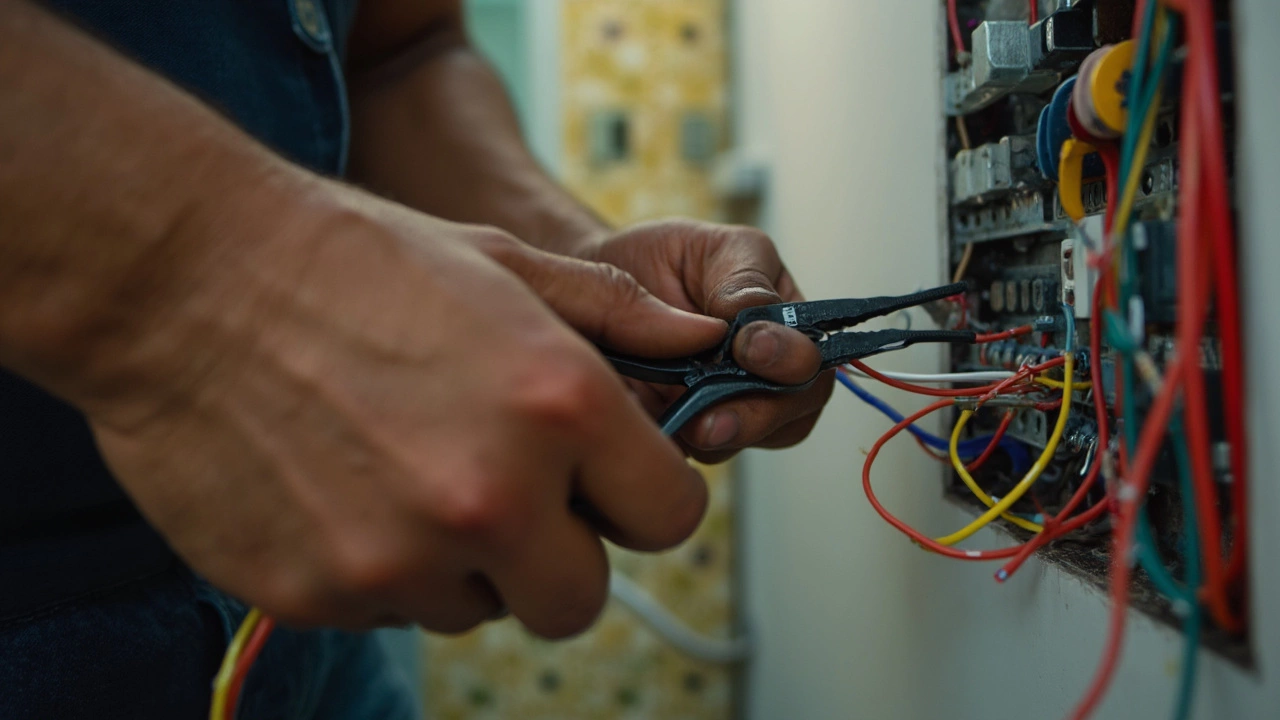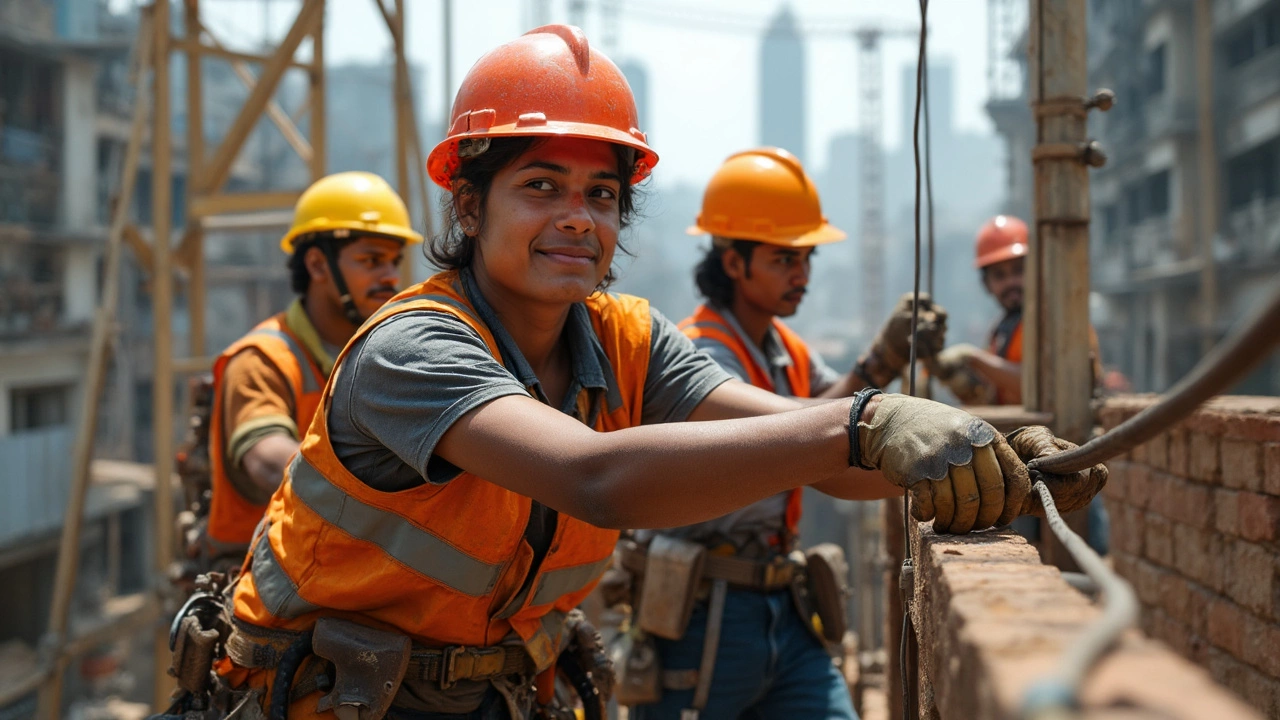Is Becoming an Electrician Hard on the Body? Realities You Should Know
Bending, squatting, hauling heavy cable – being an electrician isn’t your typical desk job. This career asks a lot from your body, and you’ll feel it, especially in your back, shoulders, and knees after a long day. That’s just the reality. But is it too much for most folks to handle, or only tough in certain situations?
If you’re thinking about electrician training, you probably want the honest scoop. Electricians spend hours on their feet, often crawling through tight spaces or climbing ladders. One minute you're wrestling a stiff wire above your head, the next you're wedged behind a massive washing machine. This kind of work can be surprisingly physical, and sometimes stressful for your joints and muscles.
- What's Physically Tough About the Job?
- Common Aches, Strains, and Health Risks
- Ways to Stay Safe and Avoid Injury
- How Training Prepares You for Physical Work
- Real Talk: Is It Worth It for Your Body?
What's Physically Tough About the Job?
Being an electrician is a pretty hands-on gig. We're not just talking about screwing in light bulbs or replacing old outlets. You’re probably picturing kneeling, standing on ladders, or crawling in tight corners—and you’d be right. That’s where a lot of the physical grind comes in.
One of the big surprises for many people is just how awkward some of the work can be. Electricians often need to keep one hand steady while twisting with the other, or balance tools on high-up surfaces while working at shoulder height for long stretches. All that can take a toll, especially on your back and shoulders. There’s also lifting: cable reels, tool bags, sometimes even heavy industrial equipment.
“You have to be prepared for odd positions all day, sometimes your feet jammed in an attic, other times working above your head for ages. If you’re not careful, your body will let you know the next day,” notes Mike Holt, veteran electrician and respected industry trainer.
The daily grind doesn’t stop there. If you hate climbing ladders or working on scaffolding, this might not be your thing. Roofs, unfinished basements, and cramped attics are all fair game. Winter brings icy floors, summer brings sweltering attics—weather matters more than people realize.
Here’s a quick look at where the real physical strain comes from on the job:
- Frequent kneeling, squatting, and bending (sometimes all at once)
- Crawling in tight or awkward spaces
- Lifting and carrying materials (wires, toolkits, panels)
- Standing on ladders or uneven surfaces for extended periods
- Working overhead, especially with hand tools
Check out this table showing the most common physical tasks for electricians, based on job surveys in the U.S.:
| Physical Task | How Often Each Workday |
|---|---|
| Lifting/Carrying Equipment | 70% of jobs, several times a day |
| Kneeling/Crawling | 60% of jobs, at least once a day |
| Climbing Ladders/Scaffolding | 40% of jobs, regularly |
| Working Overhead | 50% of jobs, for 1+ hours |
Why is this worth calling out? Because electricians use their whole bodies nearly every day. If you’re just looking for a sit-down career, this isn’t it. But if you like being up, moving, and using your electrician training for real-world problem solving, the physical side might even feel rewarding—just know what you’re signing up for.
Common Aches, Strains, and Health Risks
Working as an electrician can wear you down in pretty specific ways. Everyone knows you face shocks and zaps on the job, but the regular grind is more about aches, strains, and long-term health stuff. Let’s get specific so you know what you’re getting into.
The most common pains show up in your lower back, knees, and shoulders. Why? You’re squatting, crawling, lifting, and reaching just about every day. Climbing ladders and carrying gear gets old quick, especially if you skip proper lifting techniques. Not using your legs to lift? Your back will let you know later.
Banged-up hands and wrists are also part of the deal. Repetitive use of pliers and screwdrivers, and wrestling wires, can lead to carpal tunnel and joint pain. Some folks develop what’s called "electrician’s elbow" (it’s like tennis elbow but from repetitive twisting and squeezing).
Electrical burns and shocks get lots of attention, and for good reason. High-voltage areas add risk. But actually, more injuries come from slips, trips, and falls than from the electricity itself. It’s all the up-and-down ladders, the crawling through attics, or working in wet spaces.
Here’s a quick look at how these issues stack up (based on real workplace data):
| Issue | Chance in Electrician Jobs |
|---|---|
| Back Strain/Injury | Very Common (about 1 in 4 electricians report back pain most months) |
| Hand/Wrist Pain | Common (1 in 5 deal with frequent soreness) |
| Slips and Falls | Common (the top cause of non-fatal injuries according to OSHA) |
| Electric Shocks/Burns | Less Common but Serious (higher risk on certain jobs) |
| Hearing Loss (from loud environments) | Uncommon, but possible over years without ear protection |
Here’s what trips up a lot of new folks: rushing through jobs or skipping safety basics. Not wearing knee pads? Expect sore knees. Using old ladders or ignoring wet surfaces? That’s when falls happen. Simple habits (like stretching before work and using the right tools) make a difference — trust me, your body will thank you after a tough week on site.
If you want to last in the electrician training world, looking after your body isn’t just smart, it’s mandatory.

Ways to Stay Safe and Avoid Injury
The truth is, almost every experienced electrician knows that good habits and the right tools go a long way. You might be young and fit now, but over time, working smart is what keeps your body in decent shape. Let’s talk about some practical ways to dodge those common aches and injuries that come with this job.
- Wear padded knee pads anytime you’re kneeling for long periods—crawling without them is a rookie mistake that plenty regret later.
- Use proper gloves to shield your hands not just from shocks but from sharp edges on wires and metal boxes.
- Lift with your legs, not your back. It sounds simple, but you’d be surprised how many end up with a tweaked back from hoisting reels of cable the wrong way.
- Stretch before and after your shift. A few quick moves loosen up your shoulders, neck, and lower back, especially after crawling in attics or reaching overhead for hours.
- Take breaks when your body screams for one. Working through the pain isn’t tough—it’s just asking for trouble tomorrow.
- Don’t skip on safety gear like a hard hat and proper boots. Electrical jobs can be unpredictable, and you want protection if something goes sideways.
- If something feels off, report it—the longer equipment or worksites go unfixed, the higher the risk for everyone.
One thing people get wrong is thinking injuries are rare. Check this out: according to the U.S. Bureau of Labor Statistics, electricians have a much higher rate of work-related injuries than the average U.S. job. Most injuries are from slips, falls, muscle strains, and not electrical shocks.
| Type of Injury | Percentage (%) |
|---|---|
| Slips, Trips, and Falls | 34 |
| Muscle Strains | 24 |
| Cuts and Lacerations | 15 |
| Electrical Burns/Shocks | 18 |
| Other | 9 |
That chart surprises a lot of folks. It’s not just the zap you need to worry about—it’s tweaking your body from moving wrong over and over. Every good electrician figures out fast that taking care of yourself means you’ll last in this career. If you get into the electrician training side, always ask about the right techniques and gear. Your future self will thank you.
How Training Prepares You for Physical Work
Electrician training is not just about learning how to wire a circuit or follow a blueprint. From day one, you’ll get hands-on practice that gets your body used to the tough stuff this job throws at you. Schools and apprenticeship programs make sure you build strength in all the right spots, from your grip to your core.
It’s a mix of classroom lessons and lab time. You’ll practice real skills in mock-up walls, attics, or crawl spaces. Lifting ladders, stretching wires, knocking out drywall – it’s standard stuff. Most programs start slow so you can learn the right form and avoid tripping yourself up (literally). By the end of training, you’ll notice you can climb, crouch, and haul tools a lot easier than when you started.
Physical work is baked in. The average apprentice spends about 70-80% of hands-on learning on their feet or up a ladder, not just behind a desk. You’ll also pick up tips from pros about how to save your knees and back—stuff like always using your legs to lift, or why a tool belt that fits matters way more than you think.
- Strength exercises are part of the curriculum: things like cable pulling, moving spools, and mounting panels.
- Safety training covers the right way to lift, use ladders, and work in weird positions, plus how to spot fatigue before it turns into an injury.
- Breaks are built in, so you learn not to overdo it for the sake of speed.
- Group work gets you used to passing and moving heavy gear with a buddy, not solo.
| Training Activity | Percent of Curriculum |
|---|---|
| Hands-on Practice | 50% |
| Classroom Safety Lessons | 20% |
| On-site Job Shadowing | 30% |
Developing these habits early will pay off. Not only will you keep your body in better shape, but you’ll cut down the risk of getting hurt later. Training is where you learn to be tough and smart—so when the real work comes, your body can keep up without burning out. That’s a huge part of becoming a electrician, and schools don’t skip this for a reason.

Real Talk: Is It Worth It for Your Body?
Electrician work isn’t kind to your body every single day, that's for sure. A lot of apprentices are surprised by how tired and sore they feel at first. But here’s something to keep in mind: most electricians get stronger, fitter, and a lot more confident with time. Your body figures out the routine and you learn the safest, smartest ways to get the job done. You don’t need to be a bodybuilder to handle this career, but you do need decent mobility and a willingness to treat your body right.
Physical strain is real, though—and it sticks around. The U.S. Bureau of Labor Statistics reported that electricians have a higher rate of musculoskeletal injuries (stuff like back sprains and shoulder strains) than many other jobs. Here’s a quick look at injury data from various trades:
| Job Title | Rate of Work-Related Injuries per 10,000 Workers (2023, BLS) |
|---|---|
| Electrician | 85 |
| Plumber | 109 |
| Construction Laborer | 209 |
| Office Worker | 12 |
So, it’s no walk in the park, but electricians aren’t at the very top of the injury list either. You’re not as exposed as, say, roofers or heavy equipment operators. Still, stuff like awkward lifts, overreaching, and tight spaces can catch up with you if you aren’t careful.
Some ways electricians protect their bodies (and you should too):
- Invest in quality knee pads, comfortable boots with support, and gloves with good grip.
- Don’t skip stretching and warm-ups before those long jobs—sounds cheesy, but it works.
- Learn proper techniques for lifting and carrying heavy stuff.
- Use power tools where it makes sense, and don’t be a hero if something’s too heavy or awkward.
If you want a job that keeps you moving instead of glued to a chair, and the thought of using your hands appeals to you, this path makes sense. It’s a trade-off: some soreness, but big rewards in decent pay, job satisfaction, and hands-on work that actually makes a difference.





